Lost Gas Mechanism and Quantitative Characterization during Injection and Production of Water-Flooded Sandstone Underground Gas Storage
Abstract
:1. Introduction
- (1)
- The storage space of the underground gas storage is large, the gas storage pressure is high and the permeability is good.
- (2)
- The underground gas storage has good trap conditions, high safety and high reliability.
- (3)
- The underground gas storage can use the fluid in the reservoir as the gasket to provide the basic pressure for it.
- (4)
- There is no need for repeated exploration in the underground gas storage, the original gas production equipment can be used.
1.1. Research Status of High-Speed Injection and Production Mechanism of Underground Gas Storage
1.2. Research on Gas Loss and Mathematical Model in Injection and Production Processes of Underground Gas Storage
2. Gas Loss during Operation of Underground Gas Storage
3. Production Mechanism of Lost Gas
3.1. Simulation of Microcosmic Formation Mechanism of Gas Loss
- (1)
- The characteristics of the pore throat and clay minerals and wettability of the reservoir are analyzed, and the micro etching model is constructed based on the core analysis data.
- (2)
- The experimental simulations of gas–drive water and water–drive gas are conducted, and the occurrence of a gas–water two-phase flow in the process of displacement and end is observed.
- (3)
- The type of gas loss is categorized according to the experimental results, and the occurrence state of the lost gas is characterized under the microcosmic conditions.
3.2. Macroscopic Quantitative Characterization of Lost Gas
- (1)
- It can significantly increase injection pressure, the highest injection pressure can reach 50 MPa, can accurately simulate high intensity injection production process.
- (2)
- The experiment can simulate the gas production process, because a moving water body is connected to the bottom of the rock, this equipment can provide pressure for the gas recovery process.
4. Mathematical Model of High-Strength Injection and Production Process
- (1)
- The fluid in the reservoir has two phases of gas and water, and the flow process of the fluid remains isothermal.
- (2)
- The viscosity, compression factor, and compression coefficient of natural gas change with the change in pressure.
- (3)
- The flow of natural gas in the pores is a high-speed non-Darcy percolation, whereas the water phase satisfies Darcy’s linear law.
- (4)
- Because the compressibility of the injected gas is much higher than the compressibility of the pores, the elasticity of the rock is ignored.
4.1. Equation of Motion
4.2. State Equation
4.3. Conversion of Natural Gas Pressure and Pseudo Pressure
4.4. Continuity Equation
4.5. Auxiliary Equations
5. Numerical Simulation of High-Strength Injection and Production Process
5.1. Numerical Simulation Division of Ban 876 Underground Gas Storage
5.2. High Pressure Physical Parameters of the Natural Gas
5.3. Gas–Water Macroscopic Motion Law in the Process of Gas Injection
- (1)
- In the process of gas injection, the main migration channel of the gas is the sand body with a high physical property that is the extension direction of the braided channel. Along this channel, the gas rapidly advances to the southeast and enters the water body to form a lost gas.
- (2)
- In other directions of poor physical property, such as the sand bar on both sides of the braided channel and sand sheet, as the pressure gradient of the gas flooding in this area decreases, the diffusion of the gas becomes slow and the gas front does not change obviously.
- (3)
- Owing to the serious pressure deficit in the southeast direction of the Ban 876 underground gas storage, the gas expands to the water body along this direction, and the gas water front moves forward by approximately 400 m, forming a gas–water transition zone of a certain width.
5.4. Gas–Water Macroscopic Motion Law in the Process of Gas Production
- (1)
- In the process of gas production, the direction of water invasion is basically consistent with the gas channeling direction in the gas injection process. The water advances rapidly toward the northwest (gas reservoir) along the high-permeability zone of the braided river.
- (2)
- On both sides of the braided channel with poor physical properties, owing to the effect of the physical properties and small scale of the water body, the invasion rate of the edge water is slow, and the gas water boundary has not changed significantly.
- (3)
- When the gas in the underground gas storage is continuously removed, the formation pressure drops drastically, and the distribution law of the fluid in the gas storage changes significantly. In the main sand body, the water comes from the northwest invade obviously, the gas–water front moves approximately 200 m toward the gas reservoir, and the gas–water transition zone with a certain width is formed in the gas storage.
5.5. Law of Gas–Water Macroscopic Movement in the Process of Injection and Production of Underground Gas Storage
- (1)
- The sand body formed by the braided channel has a high thickness and good physical property. Therefore, they are the main channels of the gas and water migration, and the direction of the gas channeling is consistent with the direction of water invasion.
- (2)
- Owing to the effect of the complex sedimentary facies, the heterogeneity of the underground gas storage is quite different, which leads to an uneven movement of the gas–water front, forming a long and narrow gas–water channel.
- (3)
- The structural fluctuation of the Ban 876 underground gas storage is minor and the total elevation difference is less than 30 m. Thus, relative seepage of the gas and water are promoted. Therefore, in the process of the high-strength injection and production, the gas–water transition zone with a width of 600 m is formed, which resulted in a decrease in the effective gas of the underground gas storage, reducing the operational efficiency of the gas reservoir.
6. Macroscopic Occurrence and Quantitative Description of Lost Gas in Underground Gas Storage
- (1)
- One type of lost gas is formed above the original GWC (gas-water contact). Because of the difference in the physical property and distribution of the remaining fluid, the injection and production processes cannot be well corresponded. Therefore, in some areas, a part of the gas is surrounded by water. When the gas is produced, the pressure decreases. This part of the gas cannot escape from the bondage of water and forms the dynamic trap lost gas (Figure 12A).
- (2)
- Another part of the lost gas is formed under the original GWC. Because of the good physical property, the channel sand body easily forms a gas–water movement channel. In case of high-speed gas injection, under a strong pressure drive, a part of the gas will move along the high-permeability channel to the water, far away from the GWC, and it will be surrounded by the water body. When the gas is extracted, the thrust of the water body is obviously far below the gas injection pressure, and this part of the gas cannot be produced, and the lost gas is formed (Figure 12B). The characteristics of this part of the lost gas are large scale, but it is generally relatively isolated and far away from the injection and production wells.
6.1. Occurrence of Lost Gas Loss above GWC
6.2. Occurrence of Lost Gas below GWC
7. Development and Utilization of Lost Gas Reasonably
- (1)
- The areas not controlled by the injection wells: the wells of the Ban 876 underground gas storage are all distributed on the mainstream line of the braided river, but this is not conducive to the gas advancing toward the thin sand bodies on both the sides. Although the sand body of the northeast is thin with a poor physical property, its area is very large. The current well network cannot control this area, and there is a certain expansion potential here. It is suggested that the two new drilling wells are arranged in this area (Figure 15a).
- (2)
- The seepage channel of the gas–water transition zone: during the gas injection process, the gas will diffuse along the main line to the water area, and during the process of gas production, the water will also invade the gas reservoir in the same direction because of the rapid pressure drop inside the gas reservoir. Owing to the effect of the physical property and well pattern control, the gas diffusion and indentation of the underground gas storage are mainly concentrated in the direction of the mainstream line. Therefore, a gas and water transition zone with a width of 630 m is formed along this direction. To develop and utilize this part of the lost gas, it is suggested that two new drilling rigs be arranged in the area (Figure 16b).
8. Discussion
8.1. The Difference between Darcy and Non-Darcy Flow in the Model
- (1)
- For the whole underground gas storage, when the model does not consider the non-Darcy effect, its stable production period will be longer, and it will remain relatively high productivity for a long time after the stable production period. But in the later development period, the situation reverses, and when the model considers the non-Darcy effect, its productivity will be higher (Figure 18A).
- (2)
- For the single well productivity, when the model considers the non-Darcy effect, it will have a significant influence on the bottom pressure of the single well. At this time, the pressure gradient in the early stage of production of gas well is larger, the flow pressure drops faster, and the gas well productivity is high. If the model does not consider the non-Darcy effect, the flow pressure drop of the gas well is slow, and the single well productivity in the same time is low (Figure 18B).
8.2. The Recommendations for Decreasing of Gas Losses
- (1)
- The undeveloped or low developed gas reservoirs should be chosen as the destination of an underground gas storage, because the more complete the gas reservoir, the smaller the amount of invasion of the water body. In this way, the storage space can be fully utilized to avoid gas leakage.
- (2)
- The main fluid percolation channel in the underground gas storage must be found out, so as to arrange the injection-production wells in the area of the channel as far as possible to cut off the intrusion route of the water body.
- (3)
- Try to use the perfect injection-production well network as far as possible to avoid the formation of blank areas, where tend to store the lost gas.
- (4)
- Reasonable injection and production pressure should be used as far as possible to avoid the gas channeling and water coning [40].
8.3. The Advantages and Disadvantages of the Construction of Underground Gas Storage
9. Conclusions
Acknowledgments
Author Contributions
Conflicts of Interest
Funding Sources
References
- Li, T.; Zhang, Y. Construction and Development of Underground Gas Storage. Oil Gas Storage Transp. 2000, 19. [Google Scholar] [CrossRef]
- Mohanty, S.; Vandergrift, T. Long Term Stability Evaluation of an Old Underground Gas Storage Cavern Using Unique Numerical Methods. Tunn. Undergr. Space Technol. 2012, 30, 145–154. [Google Scholar] [CrossRef]
- Confort, M.J.F.; Mothe, C.G. Estimating the required underground natural gas storage capacity in Brazil from the gas industry characteristics of countries with gas storage facilities. J. Nat. Gas Sci. Eng. 2014, 18, 120–130. [Google Scholar] [CrossRef]
- Hagemann, B.; Rasoulzadeh, M.; Panfilov, M.; Ganzer, L.; Reitenbach, V. Hydrogenization of underground storage of natural gas. Comput. Geosci. 2016, 20, 595–606. [Google Scholar] [CrossRef]
- Wojdan, K.; Ruszczycki, B.; Michalk, D.; Swirski, K. Method for Simulation and Optimization of Underground Gas Storage Performance. Oil Gas Sci. Technol. Rev. IFP Energies Nouv. 2014, 69, 1237–1249. [Google Scholar] [CrossRef]
- Billiotte, J.A. Experimental Micromodeling and Numerical Simulation of Gas-Water Injection-Withdraw Cycles as Applied to Underground Gas Storage. In Proceedings of the SPE Annual Technical Conference and Exhibition, New Orleans, LA, USA, 23–26 September 1990; pp. 483–491. [Google Scholar]
- Wang, Z.; Guo, P.; Zhou, D.; Gao, H. Changes of Rock Compressibility Porosity and Permeability in the Injection Process. Xinjiang Pet. Geol. 2006, 27, 191–193. [Google Scholar]
- Jha, B.; Bottazzi, F.; Wojcik, R.; Coccia, M.; Bechor, N.; McLaughlin, D.; Herring, T.; Hager, B.H.; Mantica, S.; Juanes, R. Reservoir characterization in an underground gas storage field using joint inversion of flow and geodetic data. Int. J. Numer. Anal. Methods Geomech. 2015, 39, 1619–1638. [Google Scholar] [CrossRef]
- Zhao, S.; Wang, J. Injection and Production Technology of Underground Gas Storage; Petroleum Industry Press: Beijing, China, 2000; pp. 1–15, 56–75. [Google Scholar]
- Barker, J.W.; Evans, S.C. Predictive Model for Viscous Fingering in Compositional WAG model. SPE Reserv. Eng. 1995, 10, 16–121. [Google Scholar] [CrossRef]
- Lang, Z.; Bittkow, P.; Kretzschmar, H. Reservoir-Mechanical Optimization of the Hrusky Underground Gas Storage in Czechoslovakia Using a Three-dimensional Gas Expansion Model. Energietechnik 1979, 29, 479–484. [Google Scholar]
- Damle, A.S.; Berry, R.M.; Kothari, K.M. Single-Phase Simulation of an Aquifer Gas Storage Field. In Proceedings of the SPE Gas Technology Symposium, Dallas, TX, USA, 13–15 June 1988; Article No. 17744. pp. 373–379. [Google Scholar]
- Sawyer, W.K.; Zuber, M.D.; Bues, A.D. Reservoir Simulation and Analysis of the Sciota Aquifer Gas Storage Pool. In Proceedings of the SPE Annual Western Regional Meeting, Pittsburgh, PA, USA, 9–11 November 1998; pp. 59–68. [Google Scholar]
- Bittkow, P.; Kretzschmar, H.-J.; Kana, J. Simulation of Conversion of Lobodice Underground Gas Storage Facility from Town Gas to Natural Gas. Erdoel Erdgas Kohle 1991, 107, 118–123. [Google Scholar]
- Ory, J.; Guedeney, K.; Brefort, B.; Schirrer, L. Semi-automatic History Matching Technique Applied to Aquifer Gas Storages. In Proceedings of the SPE Annual Technical Conference and Exhibition, San Antonio, TX, USA, 5–8 October 1997; pp. 177–192. [Google Scholar]
- Kurihara, M.; Liang, J.; Fujimoto, F.; Nghiem, L.; Sammon, P. Development and Application of Underground Gas Storage Simulator. In Proceedings of the SPE Asia Pacific Conference on Integrated Modelling for Asset Management, Yokohama, Japan, 25–26 April 2000; Volume 4, pp. 339–352. [Google Scholar]
- Tan, Y. Calculating Leakage of Underground Gas storage by Numerical Modeling. Nat. Gas Ind. 2003, 23, 99–101. [Google Scholar]
- Fu, Y.; Guo, X.; Du, Z.; Liu, L. Numerical Simulation Research on Underground Gas Storage Considering Fracture Deformation. J. Southwest Pet. Univ. 2007, 29, 92–94. [Google Scholar]
- Xu, Z.; Jiang, J.; Ge, J.; Zhang, L.; Chen, K. Dynamic Numerical Simulation of Injection-Production in Depleted Reservoir Underground Gas Storage. Nat. Gas Explor. Dev. 2011, 34, 53–55. [Google Scholar]
- Zhao, B.; Li, Y.; Tian, J.; Wang, Z. Numerical simulation of the injection and production effect of aquifer gas storage. Oil Gas Storage Transp. 2012, 31, 211–214. [Google Scholar]
- Wang, J.; Zhang, J.; Xie, J.; Ding, F. Initial Gas Full-component Simulation Experiment of Ban-876 Underground Gas Storage. J. Nat. Gas Sci. Eng. 2014, 18, 131–136. [Google Scholar] [CrossRef]
- Cheng, X.; Liu, G.; Xiong, J. Research on The Experimental Technology of Whole-diameter Core Water Flooding Technology. Daqing Pet. Geol. Dev. 1993, 12, 46–51. [Google Scholar]
- Lu, Y.; Zuo, S.; Ge, Z.; Xiao, S.; Cheng, Y. Experimental Study of Crack Initiation and Extension Induced by Hydraulic Fracturing in a Tree-Type Borehole Array. Energies 2016, 9, 514. [Google Scholar] [CrossRef]
- Jia, Z.; Yang, Q.; Lan, Y.; Zhang, H. Experimental Study on the Microphysical Simulation of Water Displacement Oil. Daqing Pet. Geol. Dev. 2002, 21, 46–49. [Google Scholar]
- Zhu, J.; Jang, Z.; Huang, Y. An Experimental Study of the Distribution of the Remaining Oil. J. Pet. Univ. 1997, 21, 40–42. [Google Scholar]
- Zhu, Y.; Xu, A.; Lu, X. Oil Water Displacement Experiments in Glass Micromodels for Yanan Reservoir Rocks, Changqing Oilfield. Pet. J. 1989, 10, 40–48. [Google Scholar]
- Sun, Q.; Li, Z.; Li, S.; Jiang, L.; Wang, J.; Wang, P. Utilization of Surfactant-Stabilized Foam for Enhanced Oil Recovery by Adding Nanoparticles. Energy Fuels 2014, 28, 2384–2394. [Google Scholar] [CrossRef]
- Sedaghat, M.; Mohammadzadeh, O.; Kord, S.; Chatzis, I. Heavy Oil Recovery Using ASP Flooding: A Pore-Level Experimental Study in Fractured Five-spot Micromodels. Can. J. Chem. Eng. 2016, 94, 779–791. [Google Scholar] [CrossRef]
- Peng, C.; Meng, L.; Guo, P. Development and Application of 3D Physical Model Flooding Experimental Simulation Device. Pet. Exp. Geol. 2013, 35, 570–573. [Google Scholar]
- Hou, J.; Li, Z.; Zhang, S.; Cao, X.; Song, X.; Gao, D. Experimental and Simulation Study on the Construction of Three-dimensional Network Model of Rock. China Sci. G 2008, 51, 1761–1774. [Google Scholar] [CrossRef]
- Wang, Y.; Li, X.; He, J.; Zhao, Z.; Zheng, B. Investigation of Fracturing Network Propagation in Random Naturally Fractured and Laminated Block Experiments. Energies 2016, 9, 588. [Google Scholar] [CrossRef]
- Frederick, D.C.; Graves, R.M. New Correlations to Predict Non-Darcy Flow Coefficients at Immobile and Mobile Water Saturation. In Proceedings of the SPE Annual Technical Conference and Exhibition, New Orleans, LA, USA, 25–28 September 1994. [Google Scholar]
- Geertsma, J. Estimating the Coefficient of Inertial Resistance in Fluid Flow through Porous Media. Soc. Pet. Eng. J. 1974, 14, 445–450. [Google Scholar] [CrossRef]
- Dranchuk, P.M.; Kassem, H. Calculation of Z Factors for Natural Gases Using Equations of State. J. Can. Pet. Technol. 1975, 14, 34–36. [Google Scholar] [CrossRef]
- Al-Hussainy, R.; Ramey, H.J., Jr. Application of Real Gas Flow Theory to Well Testing and Deliverability Forecasting. J. Pet. Technol. 1966, 18, 637–642. [Google Scholar] [CrossRef]
- Ding, G.; Xie, P. Current Situation and Development of Underground Gas Storage in China. Nat. Gas Ind. 2006, 26, 111–113. [Google Scholar]
- Tian, W.; Wang, M.; Zhu, W.; Han, J.; Nie, F. Study on the law of oil, gas and water three phase seepage in tight sandstone. J. Shaanxi Univ. Sci. Technol. 2016, 34, 114–118. [Google Scholar]
- Zhang, Q.; Lu, T.; Lu, J. Non Darcy Flow Binomial Deliverability Test Formula. Nat. Gas Ind. 2004, 24, 83–85. [Google Scholar]
- Zhao, X.; Yao, A.J.; Cui, C.; Su, Y. High Speed Non-Darcy Percolation Model Considering Real Gas PVT Dynamics. Oil Drill. Technol. 2009, 37, 78–81. [Google Scholar]
- Le Van, S.; Chon, B.H. Applicability of an Artificial Neural Network for Predicting Water-Alternating-CO2 Performance. Energies 2017, 10, 842. [Google Scholar] [CrossRef]
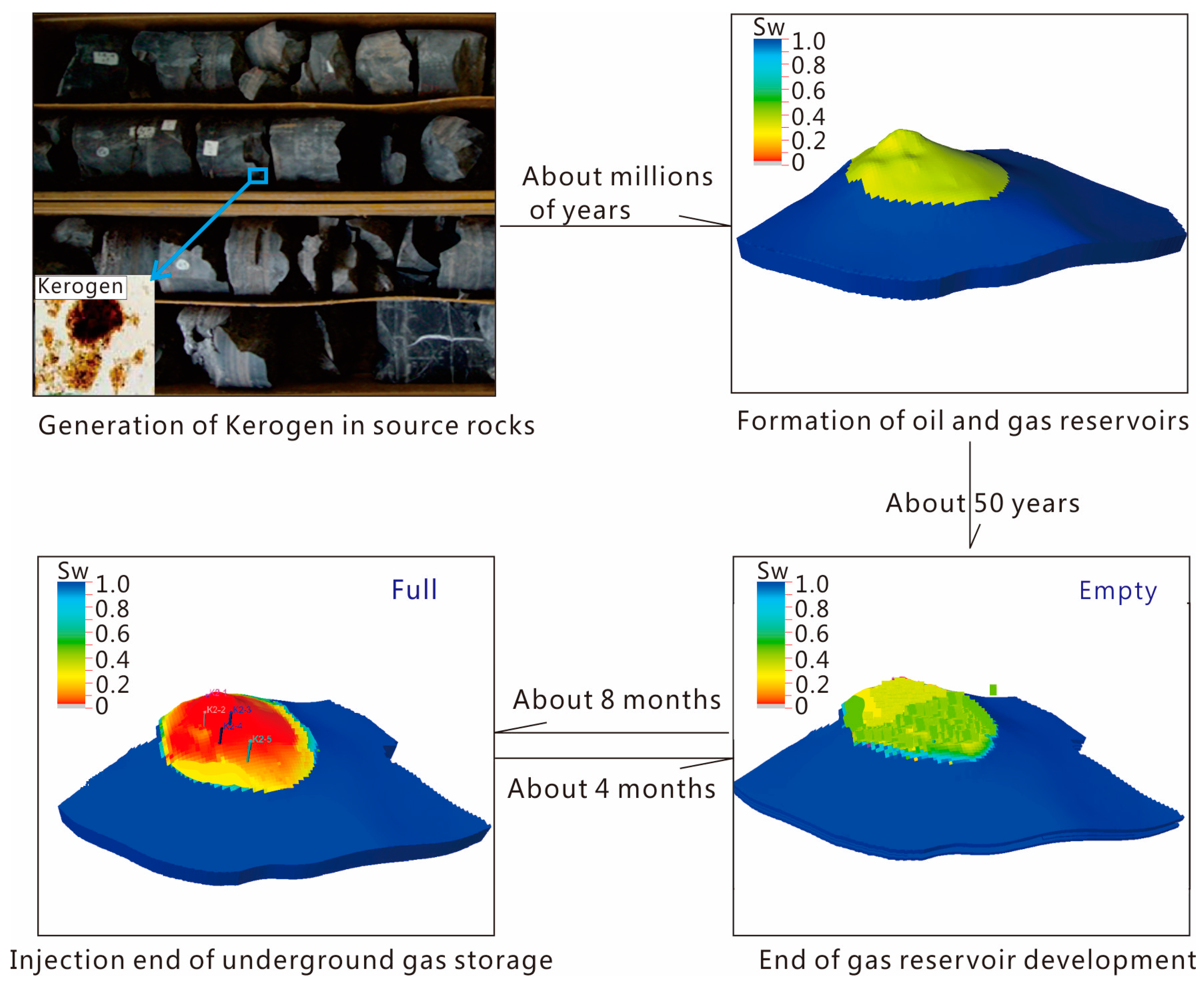
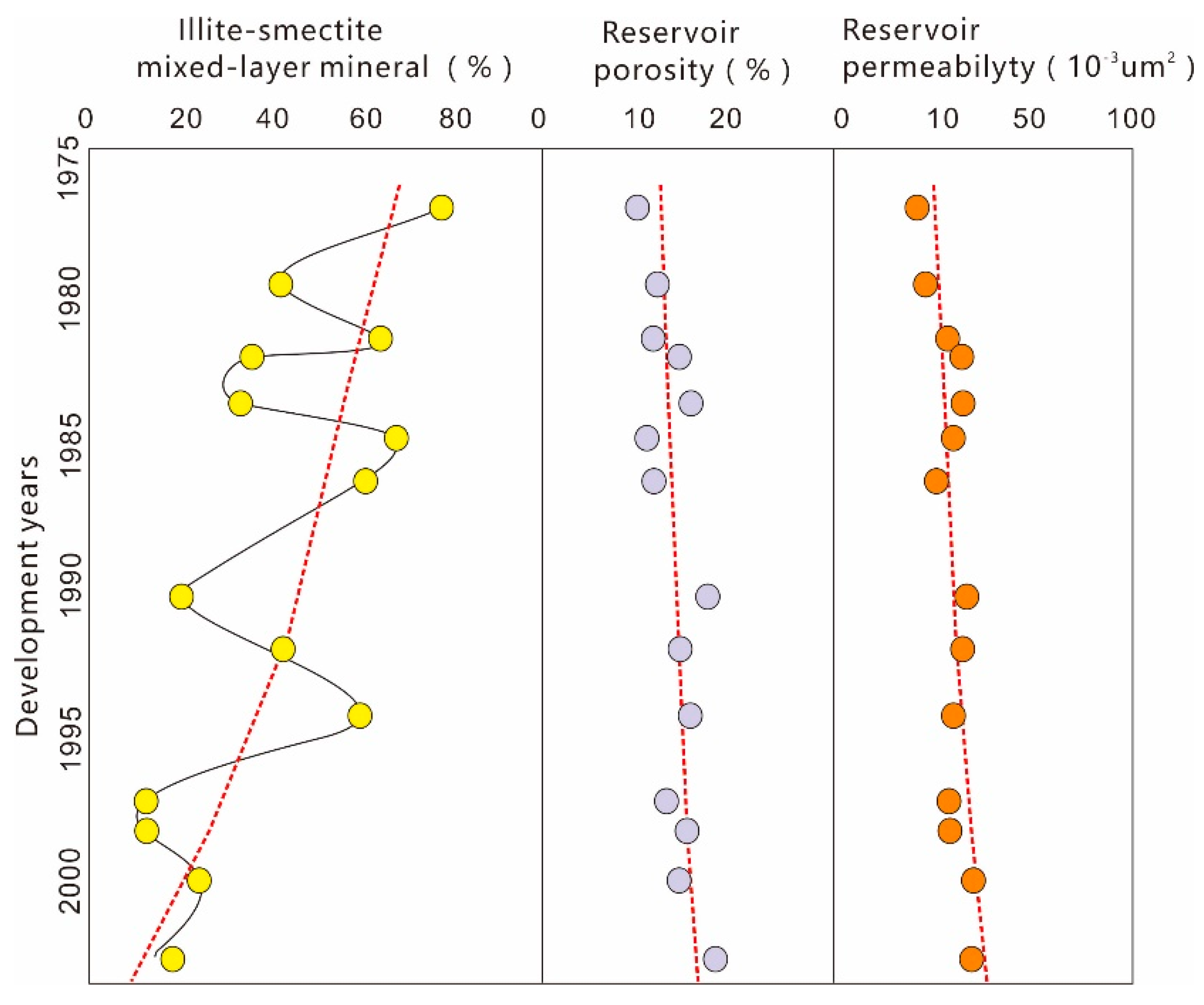
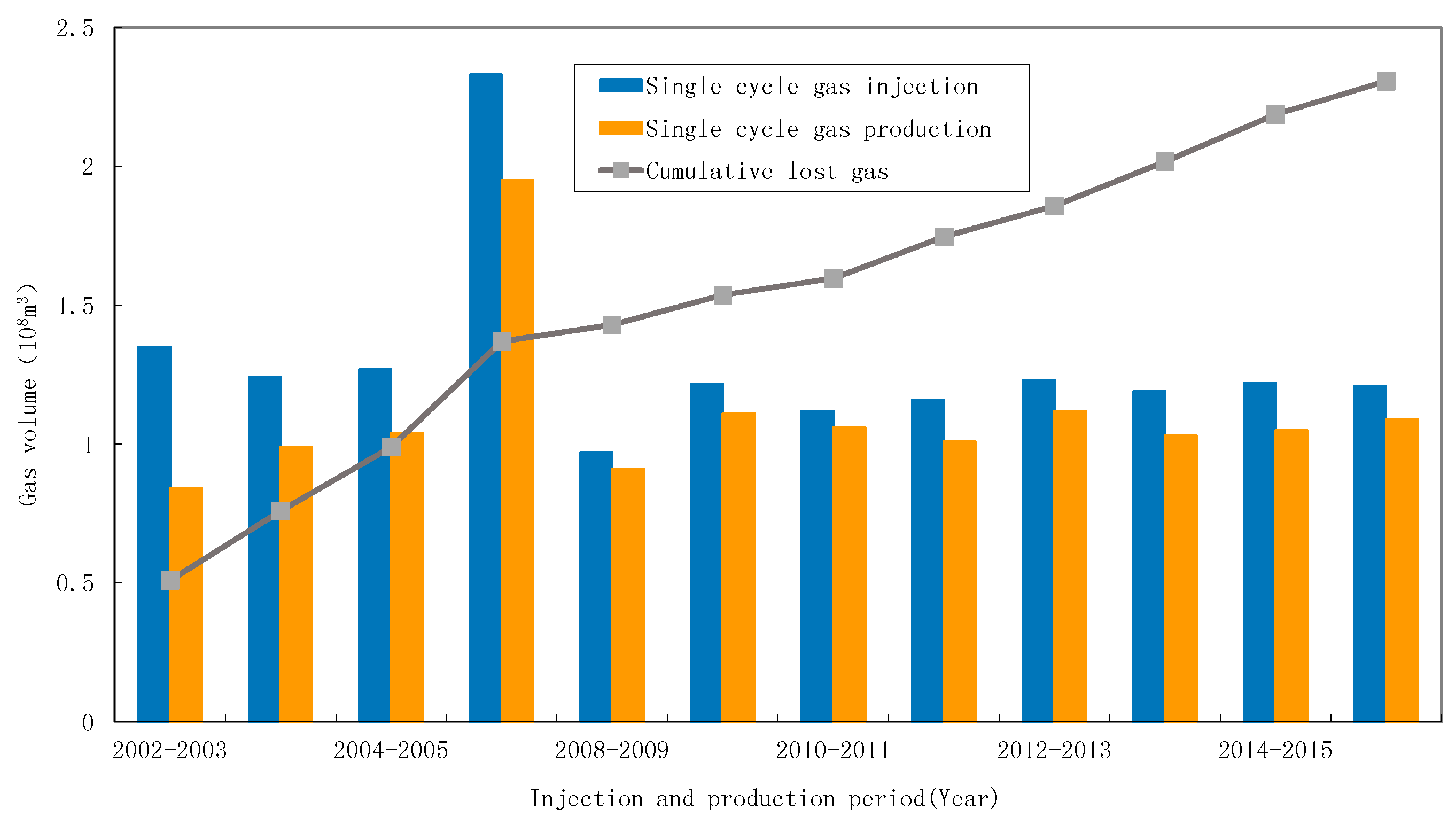
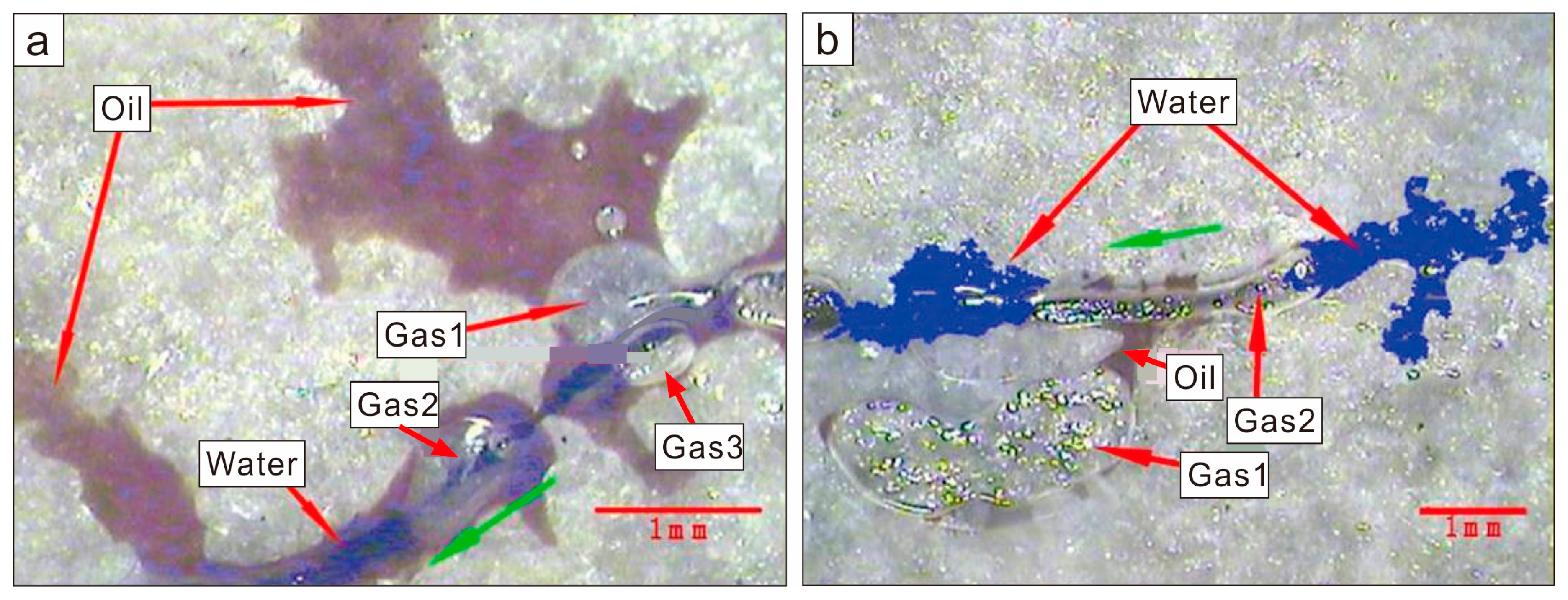
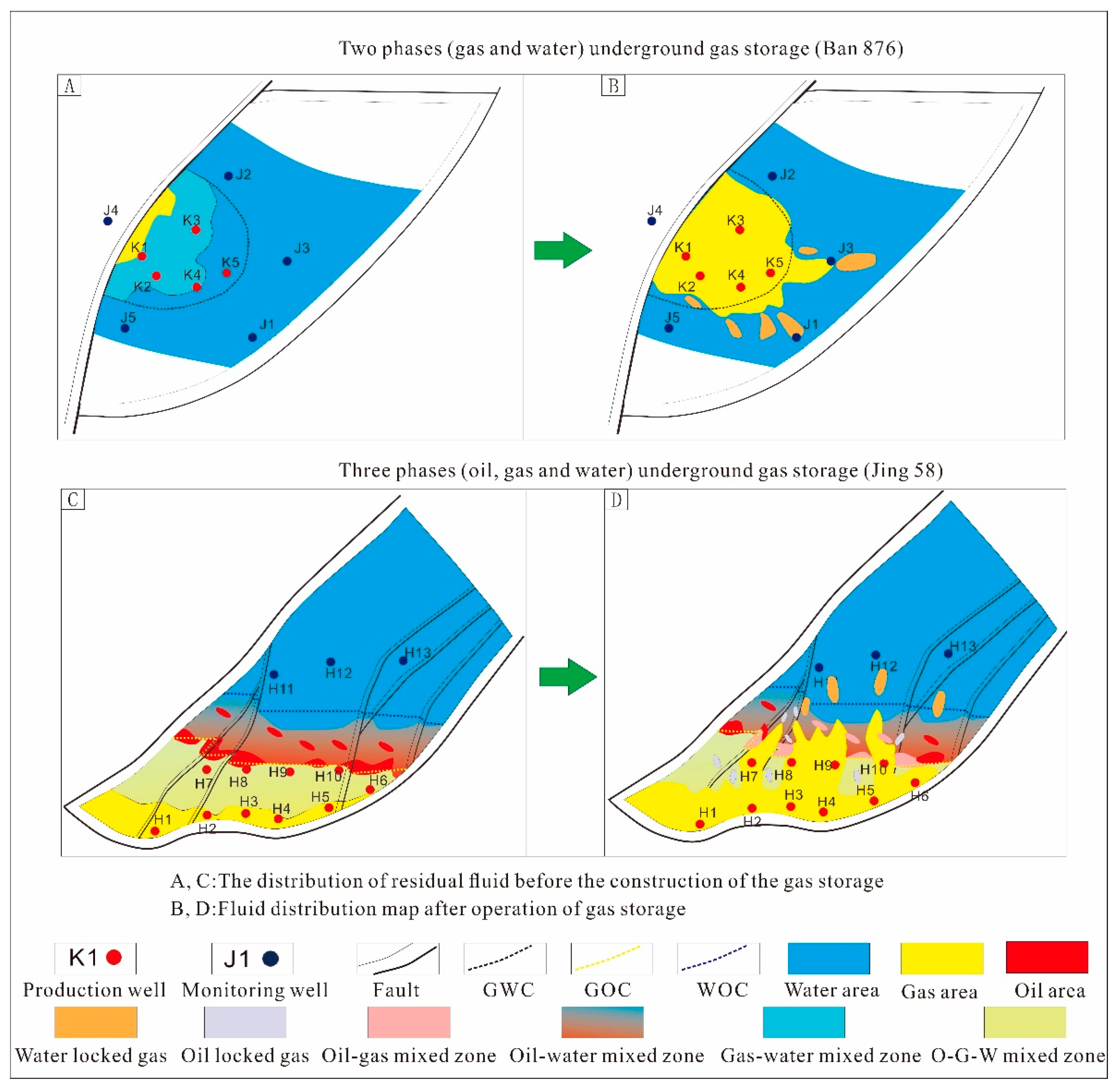

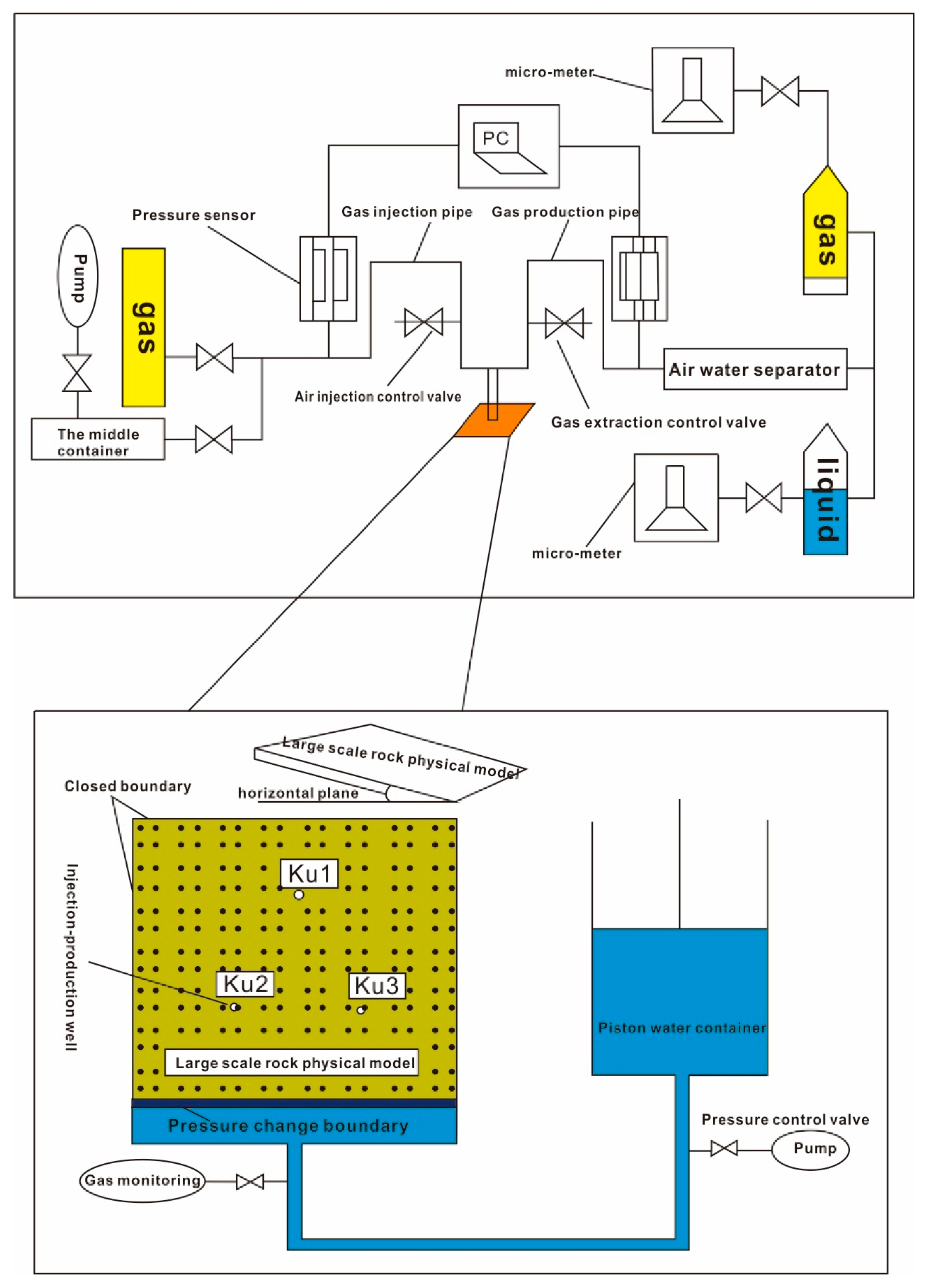
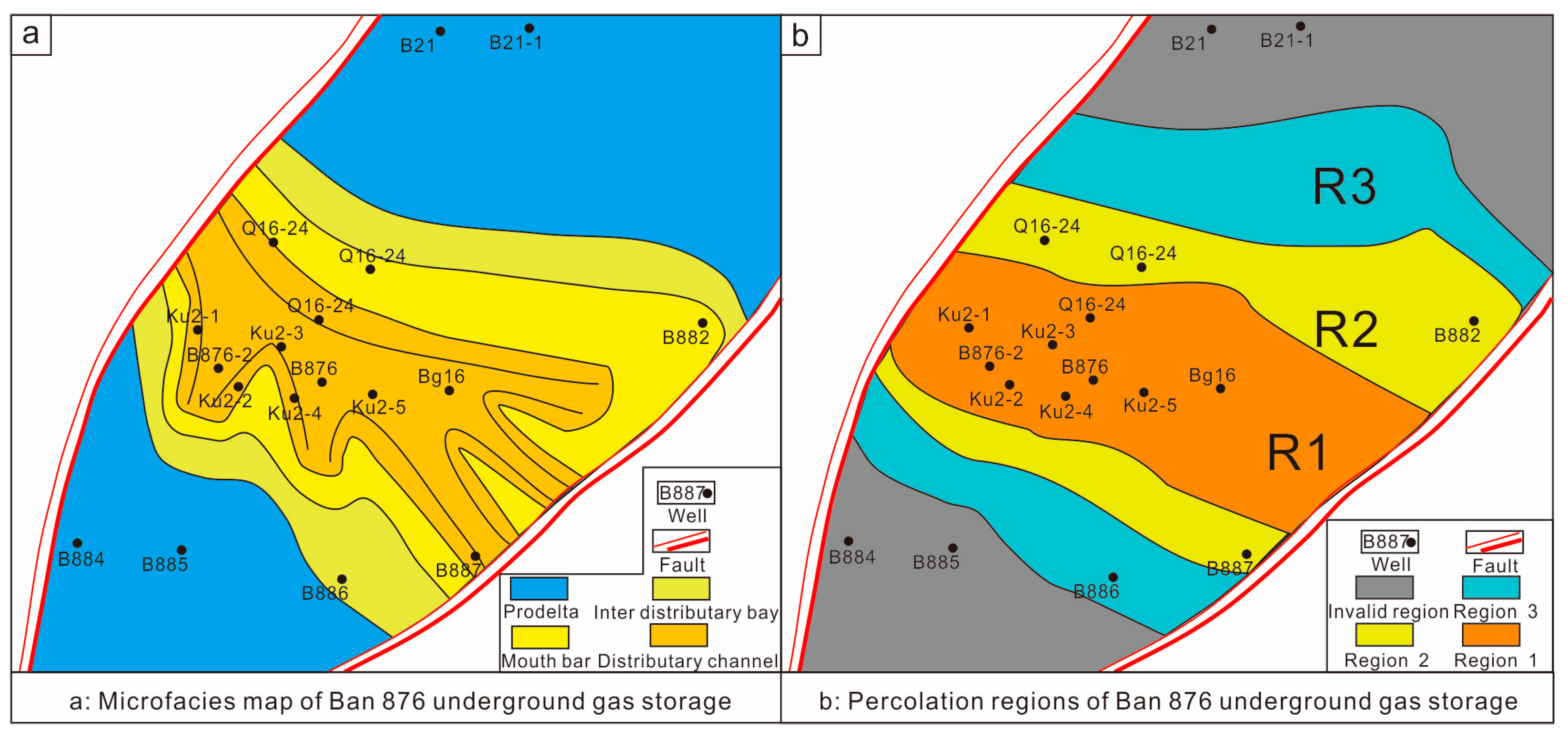
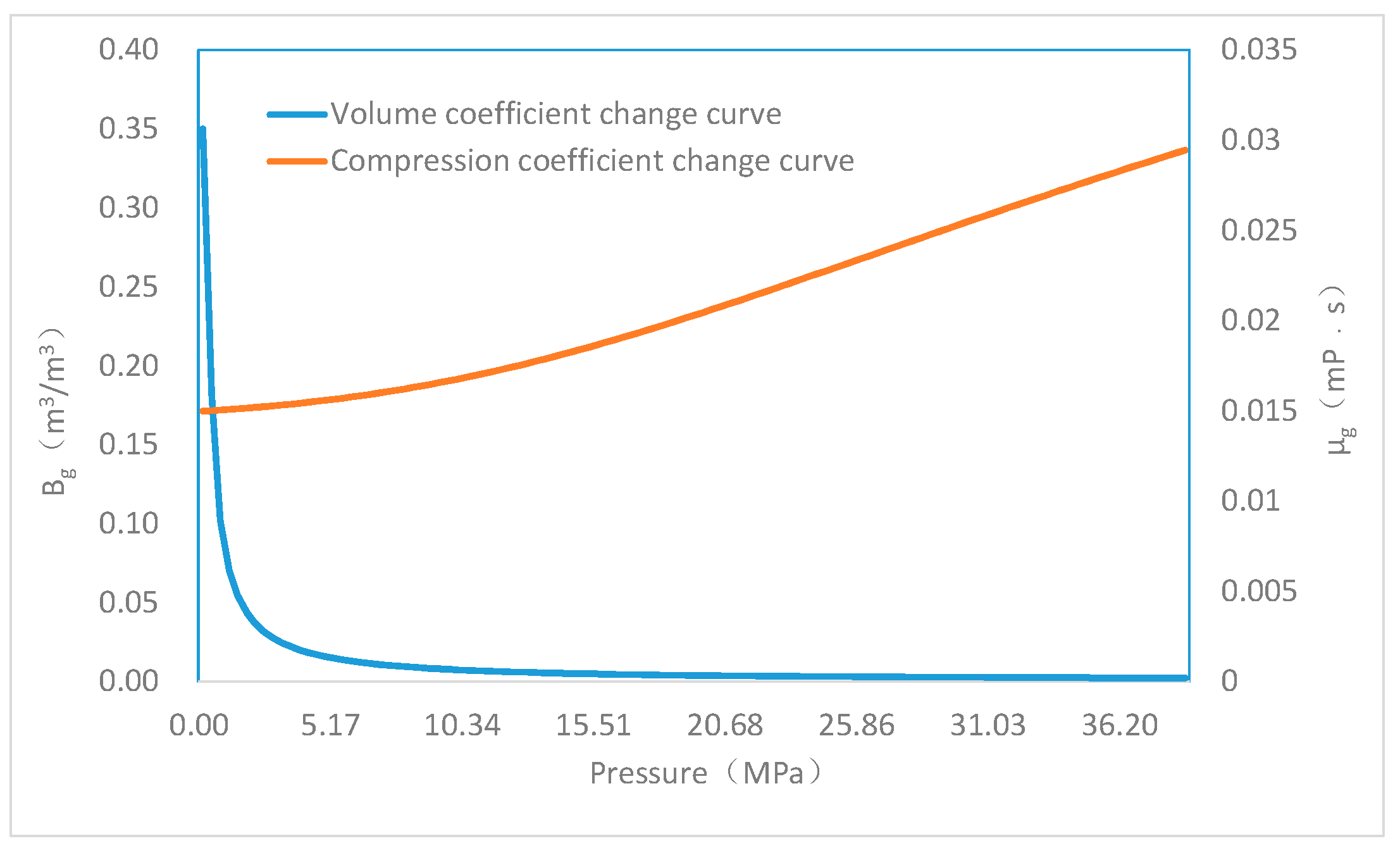
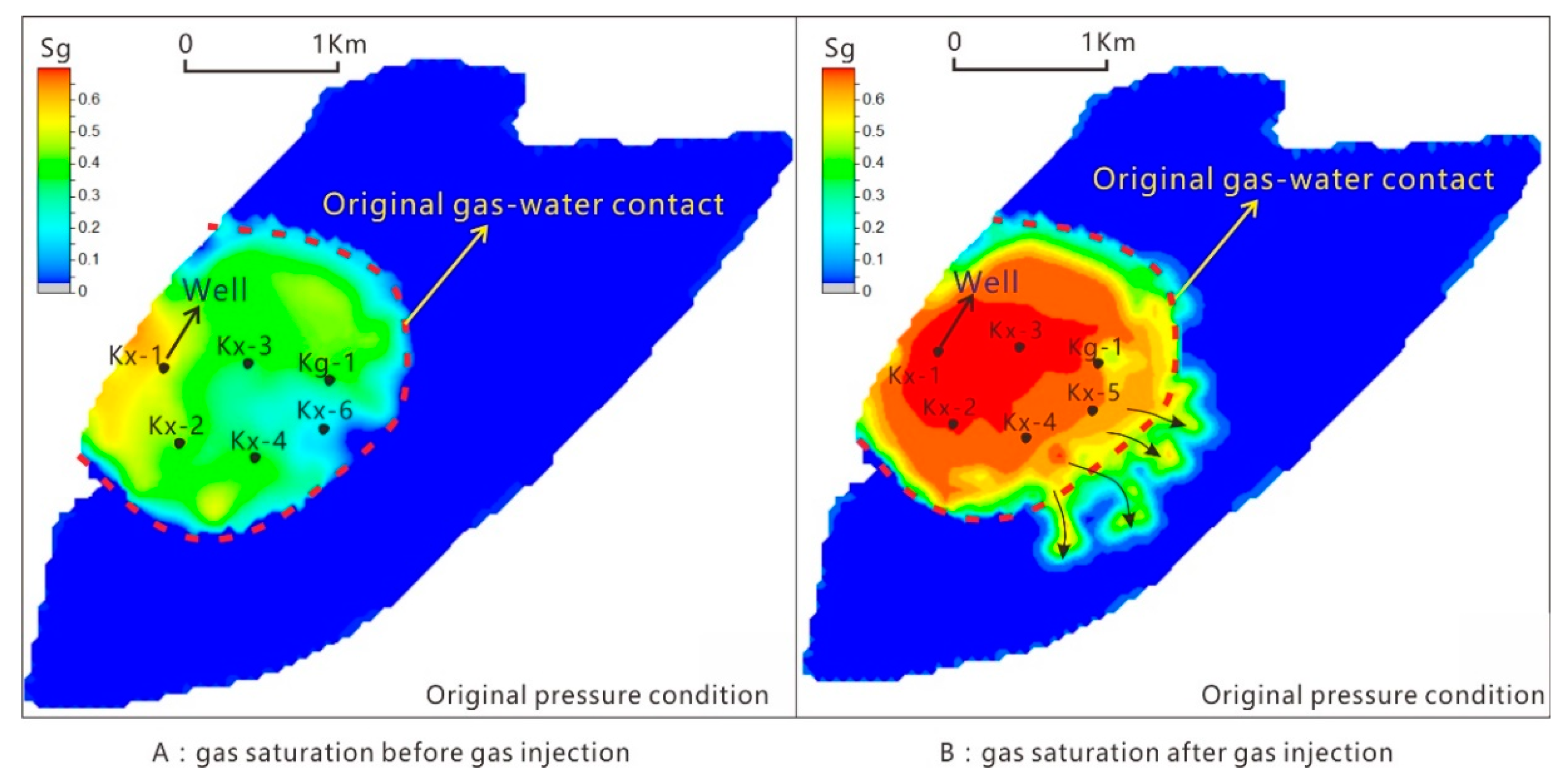

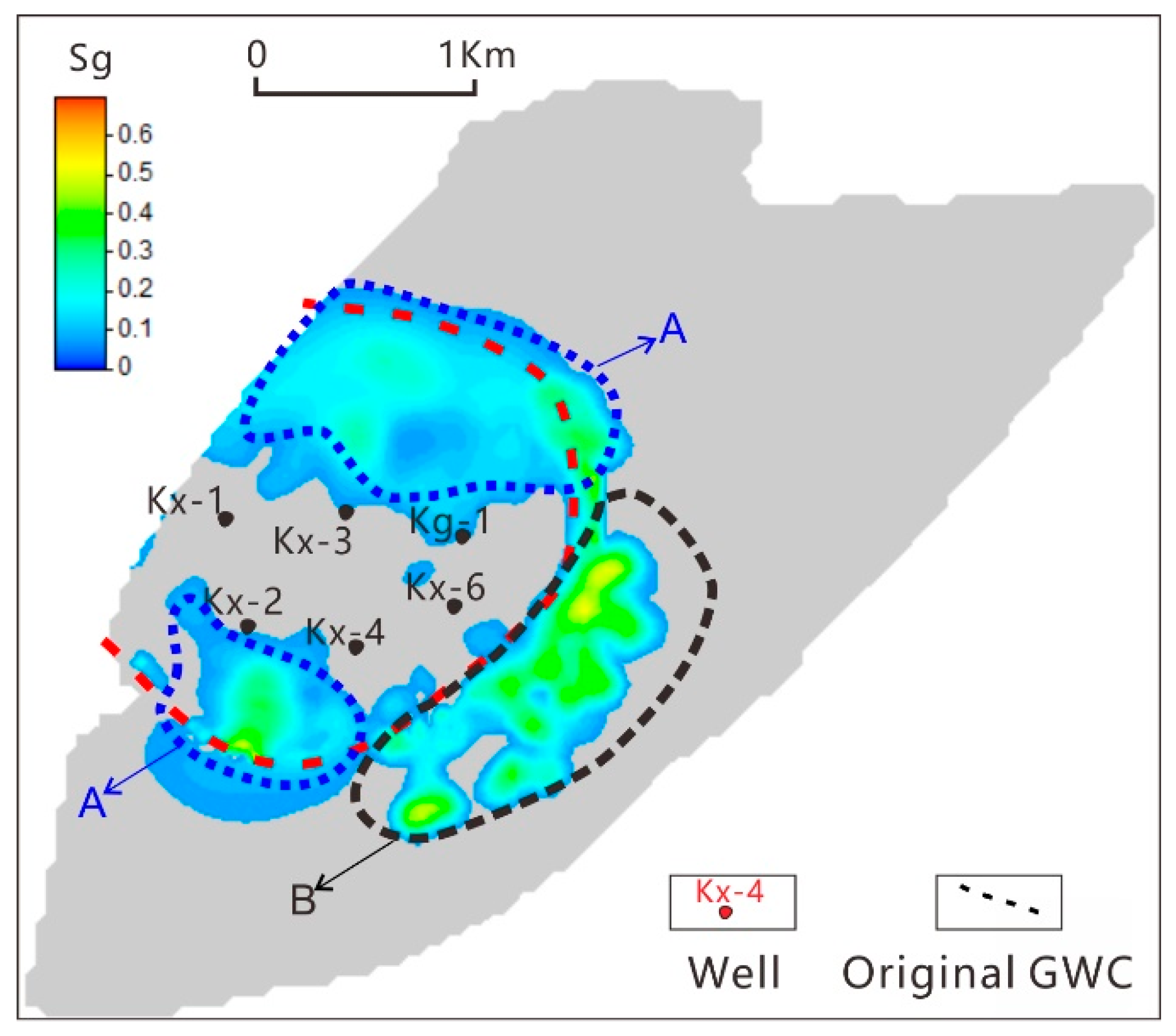
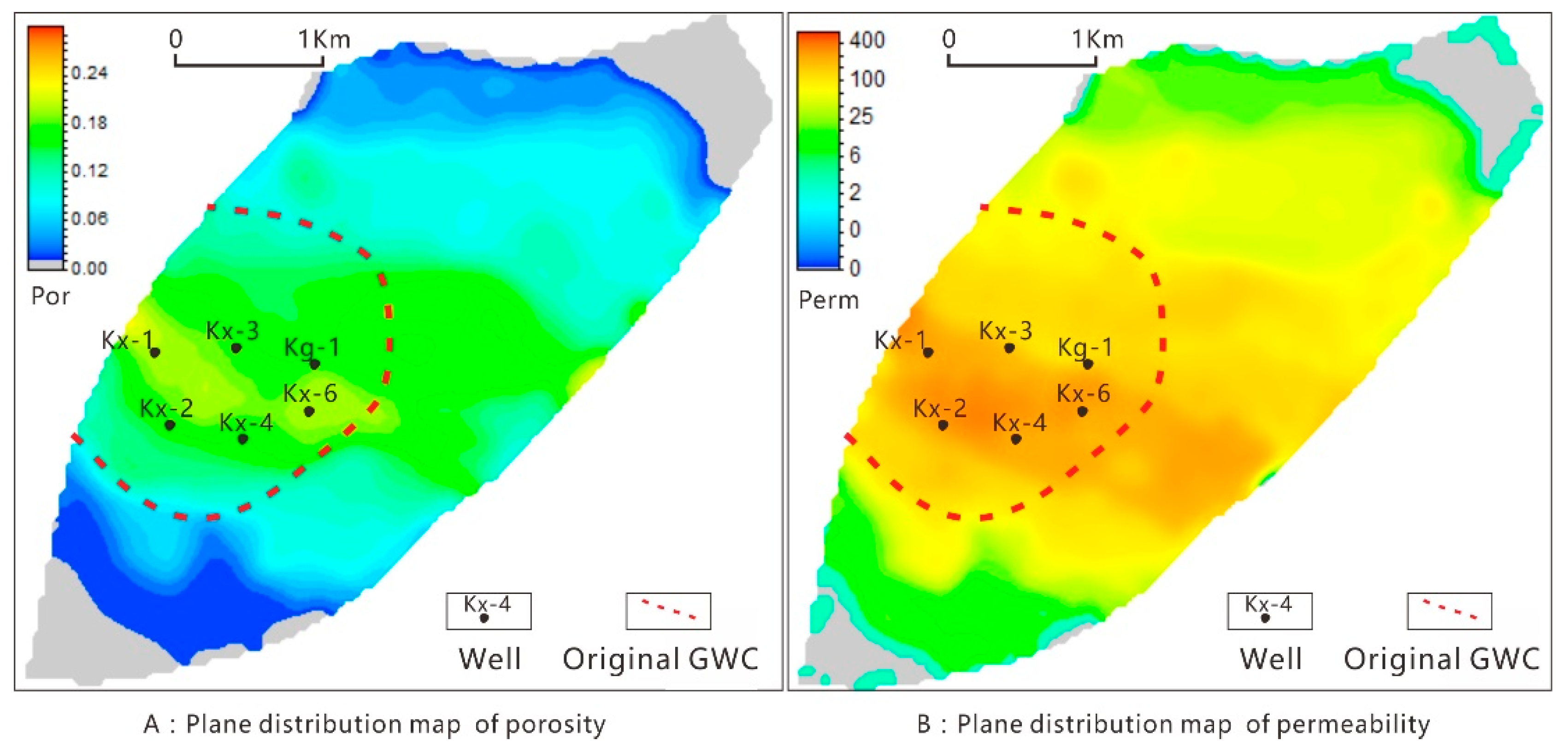
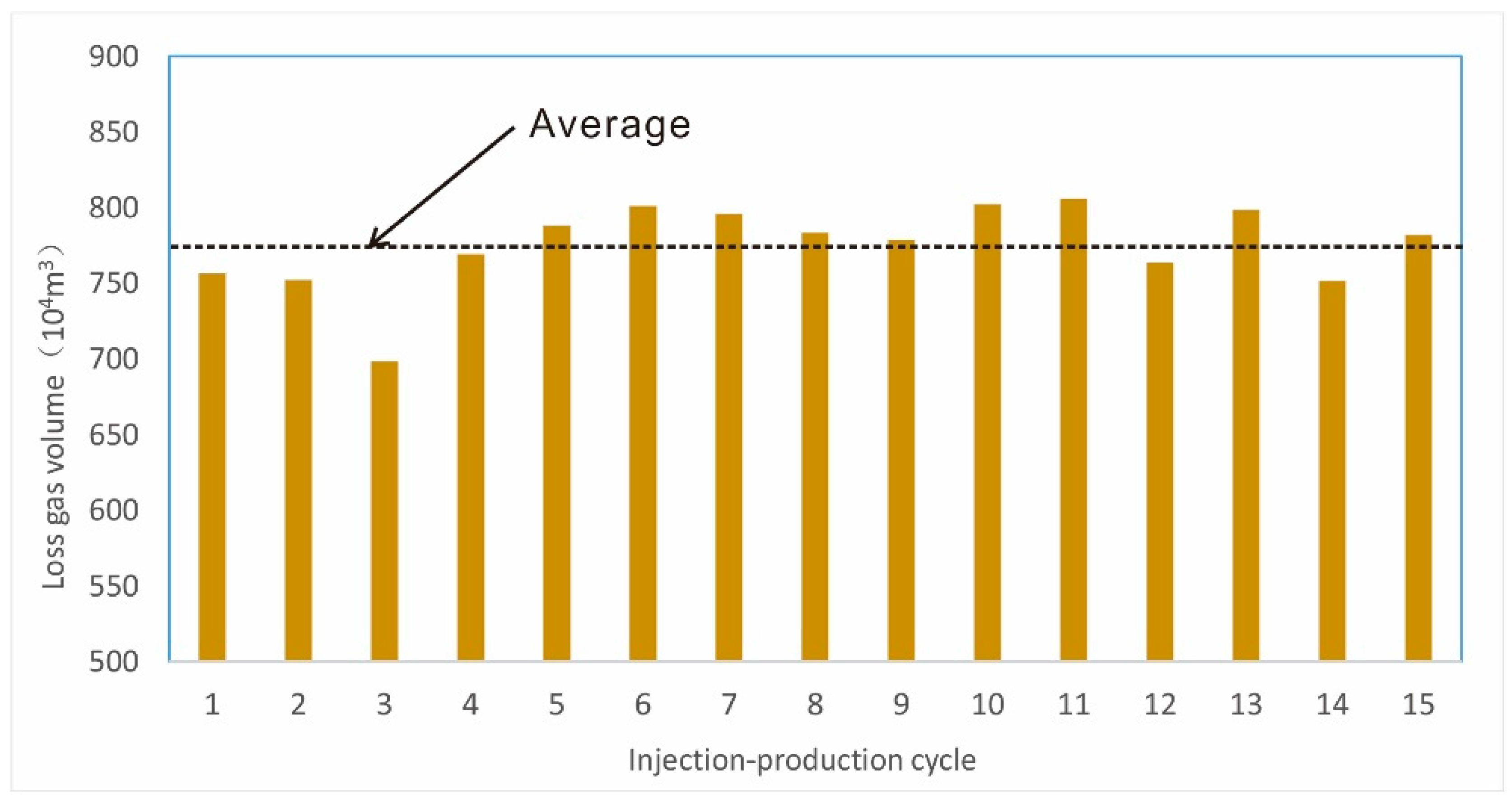
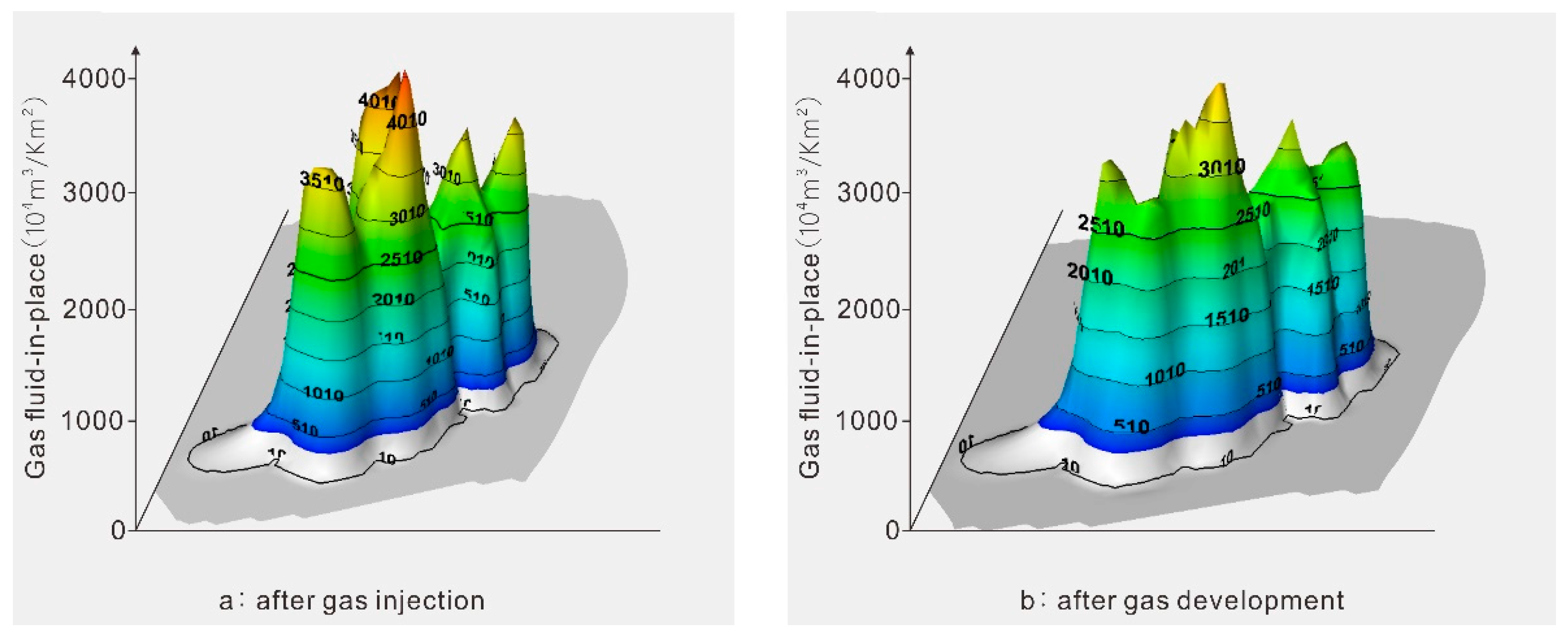
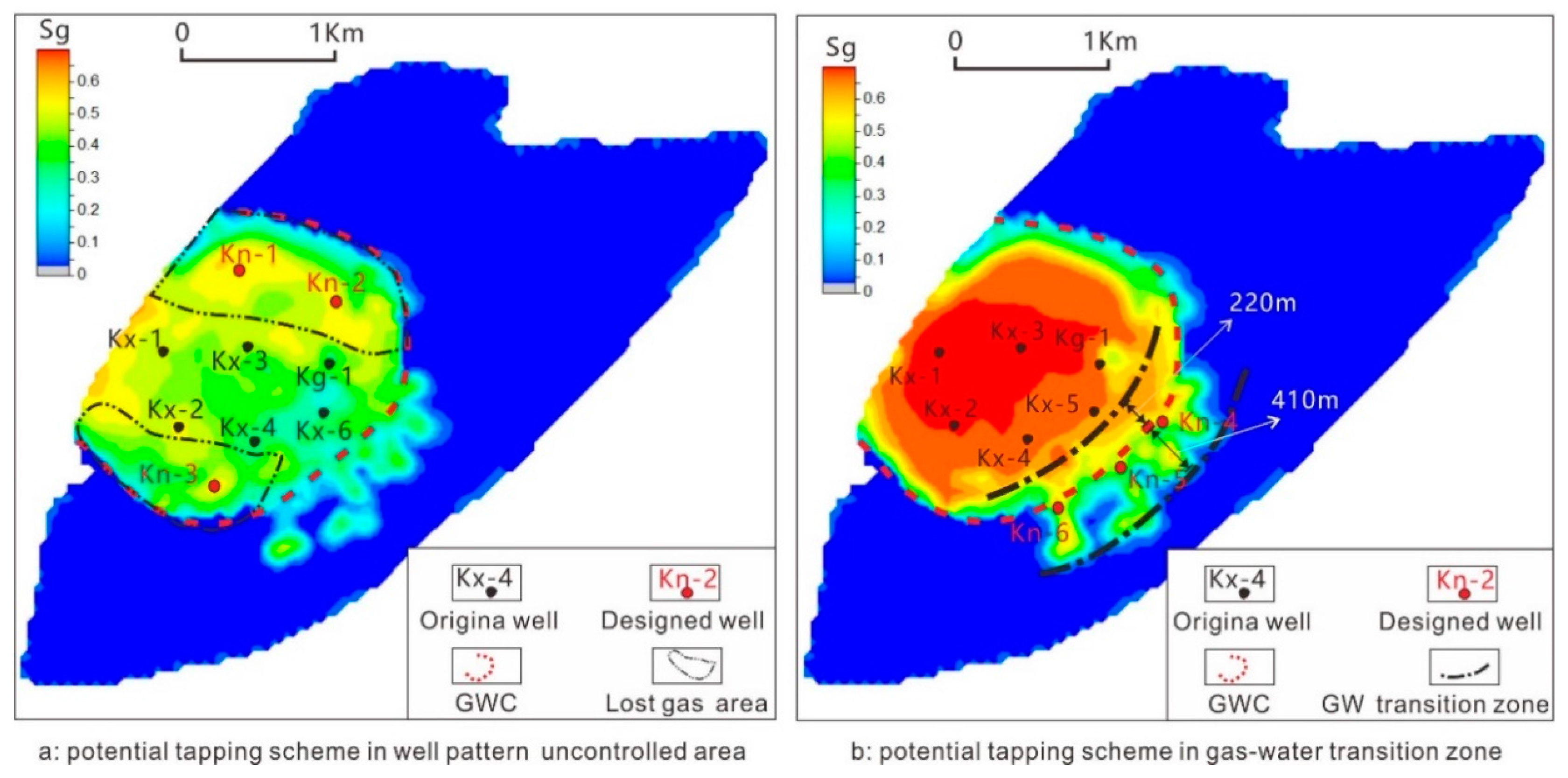
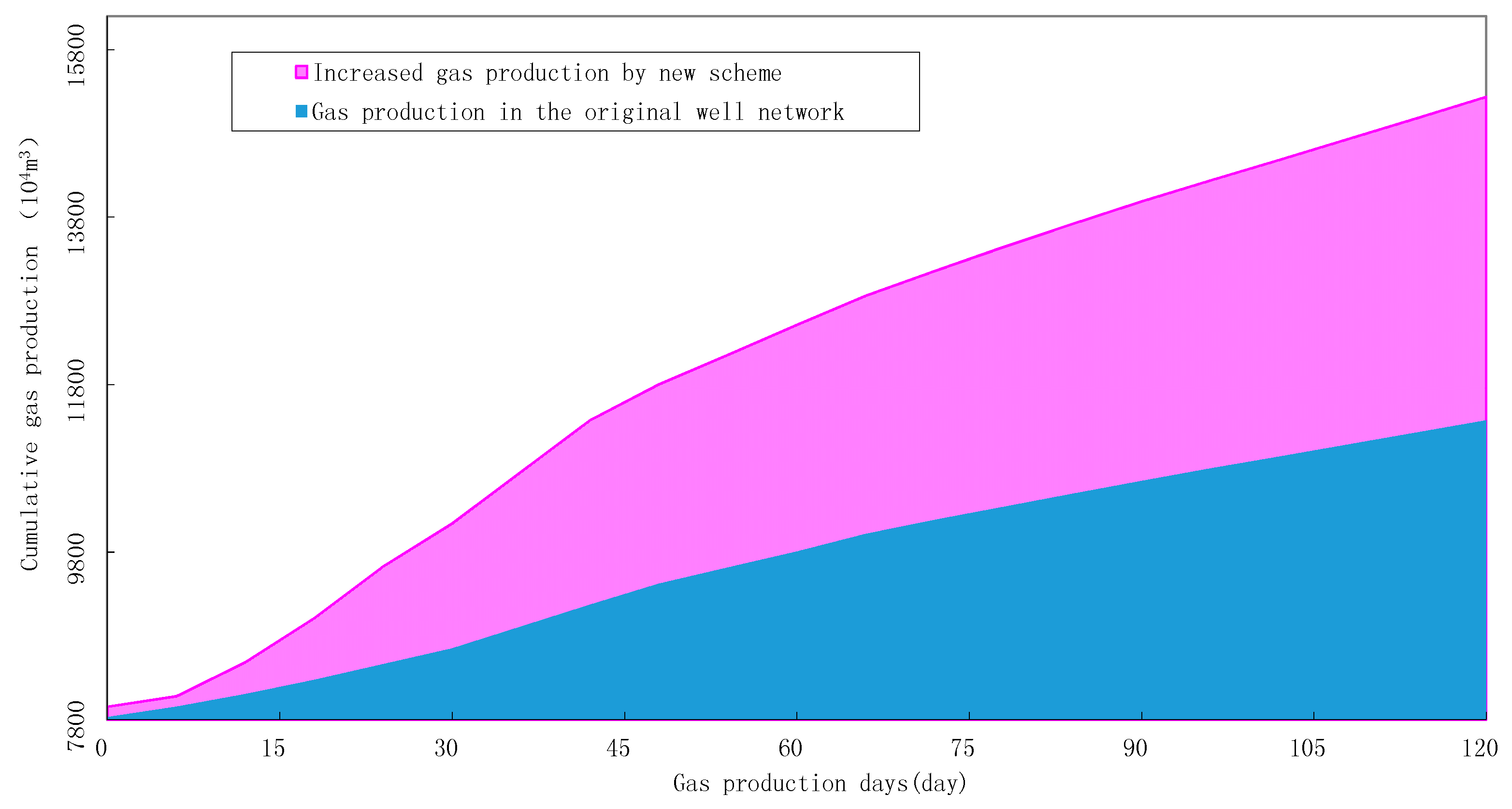
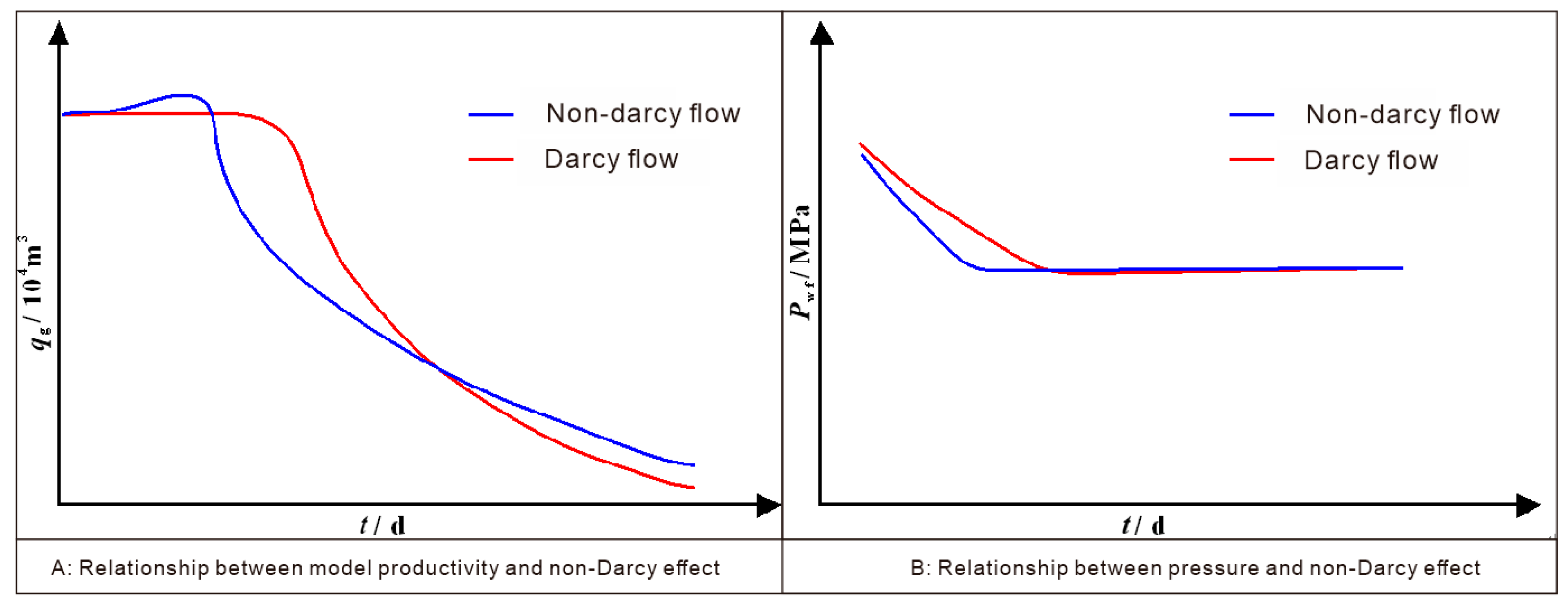
| Sample Number | Experimental Serial Number | Gas Injection(m3) | Gas Ptoduction(m3) | Water Production(mm3) | Produced Water Volume(PV) | Lost Gas Volume(m3) |
|---|---|---|---|---|---|---|
| B-1 | 1 | 0.324 | 0.263 | 0.184 | 20 | 0.061 |
| B-1 | 2 | 0.295 | 0.222 | 0.237 | 26 | 0.073 |
| B-1 | 3 | 0.321 | 0.244 | 0.253 | 28 | 0.077 |
| B-1 | 4 | 0.372 | 0.275 | 0.192 | 21 | 0.097 |
| B-1 | 5 | 0.311 | 0.252 | 0.224 | 25 | 0.059 |
| B-2 | 1 | 0.283 | 0.221 | 0.176 | 20 | 0.062 |
| B-2 | 2 | 0.312 | 0.223 | 0.255 | 28 | 0.089 |
| B-2 | 3 | 0.259 | 0.167 | 0.211 | 23 | 0.092 |
| B-2 | 4 | 0.274 | 0.216 | 0.222 | 25 | 0.058 |
| B-2 | 5 | 0.342 | 0.268 | 0.265 | 29 | 0.074 |
| B-3 | 1 | 0.263 | 0.189 | 0.211 | 23 | 0.074 |
| B-3 | 2 | 0.272 | 0.206 | 0.191 | 21 | 0.066 |
| B-3 | 3 | 0.257 | 0.175 | 0.215 | 24 | 0.082 |
| B-3 | 4 | 0.276 | 0.222 | 0.189 | 21 | 0.054 |
| B-3 | 5 | 0.345 | 0.261 | 0.212 | 24 | 0.084 |
| Formation pressure (MPa) | 21 |
| Formation temperature (°C) | 89 |
| Natural gas density (g/cm3) | 0.0001 |
| Rock compression coefficient (10−4 MPa−1) | 4.575 |
| Formation water viscosity (mPa·s) | 0.38 |
| Viscosity parameters of formation water (1/MPa) | 3.28 × 10−4 |
© 2018 by the authors. Licensee MDPI, Basel, Switzerland. This article is an open access article distributed under the terms and conditions of the Creative Commons Attribution (CC BY) license (http://creativecommons.org/licenses/by/4.0/).
Share and Cite
Wang, J.; Liu, H.; Zhang, J.; Xie, J. Lost Gas Mechanism and Quantitative Characterization during Injection and Production of Water-Flooded Sandstone Underground Gas Storage. Energies 2018, 11, 272. https://doi.org/10.3390/en11020272
Wang J, Liu H, Zhang J, Xie J. Lost Gas Mechanism and Quantitative Characterization during Injection and Production of Water-Flooded Sandstone Underground Gas Storage. Energies. 2018; 11(2):272. https://doi.org/10.3390/en11020272
Chicago/Turabian StyleWang, Jinkai, Hengyi Liu, Jinliang Zhang, and Jun Xie. 2018. "Lost Gas Mechanism and Quantitative Characterization during Injection and Production of Water-Flooded Sandstone Underground Gas Storage" Energies 11, no. 2: 272. https://doi.org/10.3390/en11020272
APA StyleWang, J., Liu, H., Zhang, J., & Xie, J. (2018). Lost Gas Mechanism and Quantitative Characterization during Injection and Production of Water-Flooded Sandstone Underground Gas Storage. Energies, 11(2), 272. https://doi.org/10.3390/en11020272




